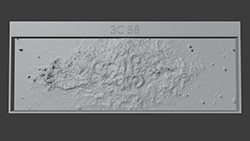CXC Home | Search | Help | Image Use Policy | Latest Images | Privacy | Accessibility | Glossary | Q&A
1
X-ray & Optical Images of 3C 58Credit: X-ray: NASA/CXC/ICE-CSIC/A. Marino et al.; Optical: SDSS; Image Processing: NASA/CXC/SAO/J. Major
Astronomers studied neutron stars, including one in the center of the 3C 58 supernova remnant, to probe the nature of matter inside these very dense objects. A study using data from Chandra and XMM-Newton reveals that the interiors of some neutron stars may contain a type of ultra-dense matter not found anywhere else in the Universe.
In these images of 3C 58, low-energy X-rays are shown in red, medium-energy X-rays in green, and the high-energy band of X-rays is shown in blue. An optical image of the same patch of sky from the Digitized Sky Survey is also provided.
In these images of 3C 58, low-energy X-rays are shown in red, medium-energy X-rays in green, and the high-energy band of X-rays is shown in blue. An optical image of the same patch of sky from the Digitized Sky Survey is also provided.
2
Illustration of a Neutron StarCredit: ICE-CSIC/D. Futselaar/Marino et al.
An artist's illustration of a neutron star, shown as a bright blue and red sphere with spark-like features flying off it. Several blue magnetic field lines loop connect the sphere's two poles. The sphere is surrounded by a see-through purple cloud, and with a red cloud on the sides of the image. Stars are visible in the background.
3
3D Printable Files: 3C 58(3D Print Credit: NASA/CXC/A. Jubett, using software by Tactile Universe/N. Bonne & C. Krawczyk & Blender)
This tactile plate is a physical relief map based on the intensity of X-ray data, depicting the leftovers from an exploded star called 3C 58. At the center of the remnant is a rapidly spinning neutron star, called a pulsar, that presents itself as a raised object that's somewhat elongated in shape.
Loops and swirls of material extend outward from the neutron star in many directions, resembling the shape of an octopus and its arms.
Surrounding the octopus-like structure is a cloud of material that is wider horizontally than it is vertically. A ribbon of material extends to the left edge of the cloud, curling upward at its conclusion. Another ribbon extends to the right edge of the cloud, though it is less defined than the one on the other side.
Loops and swirls of material extend outward from the neutron star in many directions, resembling the shape of an octopus and its arms.
Surrounding the octopus-like structure is a cloud of material that is wider horizontally than it is vertically. A ribbon of material extends to the left edge of the cloud, curling upward at its conclusion. Another ribbon extends to the right edge of the cloud, though it is less defined than the one on the other side.
Return to: NASA's Chandra Peers Into Densest and Weirdest Stars (June 20, 2024)







